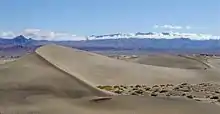barchan
English

A barchan.
Alternative forms
Pronunciation
- IPA(key): /bɑːˈkɑːn/
Noun
barchan (plural barchans)
- An arc-shaped sand ridge comprising well-sorted sand.
- 1988, Robert Irwin, The Mysteries of Algiers, Dedalus 1993, p. 69:
- But to follow the dunes around the foot of their slopes is also tedious and one can walk for half a kilometre east or west, finding one barchan linked to another and no easy way through […].
- 2008, Julie Laity, Deserts and Desert Environments, page 205:
- Barchans and transverse dunes are essentially of the same type, forming and migrating under a unidirectional wind regime. The difference between the two is related to the amount of sand: barchans are isolated mounds, whereas transverse dunes are composed of many barchans coalesced into a single, longer dune form (Tsoar 2001).
- 2010, Robert S. Anderson, Suzanne P. Anderson, Geomorphology: The Mechanics and Chemistry of Landscapes, page 482,
- Perhaps the most distinctive is the barchan dune, an isolated crescentic form with arms that stretch downwind. Barchans are not huge, often with heights of only a few meters.
Translations
arc-shaped sand ridge
|
This article is issued from Wiktionary. The text is licensed under Creative Commons - Attribution - Sharealike. Additional terms may apply for the media files.